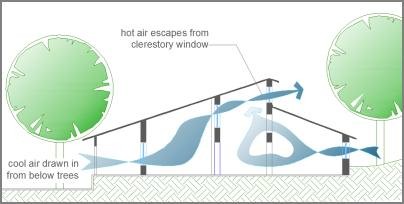Passive cooling In tropical climates can be achieved by intelligent architectural design.In tropical climates, it’s important to keep the interior of a building cool and it is known as “passive cooling” because the reliance on “active” or mechanical means (air-conditioning) is kept to a minimum. In most parts of India, it is wise to keep direct sun away from the interiors of the building especially during the hot months. Allowing direct egress and glare leads to a build-up of heat and discomfort. This can be avoided by having deep roof overhangs and chajjas. Other methods of passive cooling depend on the local climatic factors.
Thermal Mass
In extreme climates which are usually also dry, you want to insulate yourself from the elements. For example in parts of Madhya Pradesh and Rajasthan, a hot and sand-laden wind (known as loo) is common in May. Under such circumstances, cross ventilation is something that you desperately want to avoid. In places like this, the openings are kept small and the walls are made so thick that by the time the heat manages to penetrate, the day is more or less over. Also, if you look at the local architecture, you will notice that all the structures are huddled together as if protecting each other from their harsh surroundings; which is, in fact, exactly what they’re doing.
Sun Studies
Sun Study
With the advent of computers and advanced software, what was once a tedious and error-prone manual procedure can now be completed by pressing a button. Sun studies help immensely in determining where and when sunlight enters a building, allowing the architect to accurately design awnings, verandahs and roof overhangs and even help in the placement of large trees which can provide shade.
The animation above was created using ArchiCAD – a parametric architectural package which is excellent, not only because one can design directly in 3D but, also, because it automatically calculates shadows for a given structure at any chosen date and time.
Cross Ventilation
In humid places like the coastal areas of our country, comfort is achieved by having air flowing over your skin; evaporating the sweat and cooling your body. For this, it is advisable to have large openings in the building’s envelope. However, deep overhangs need to be used to minimise direct entry of sunlight (read: heat) otherwise you’ll have hot air blowing over you, which pretty much defeats the purpose of the exercise, doesn’t it?
In addition, openings can be strategically placed to allow the heat to escape. In a single-storey house, high-level or clerestory windows allow hot air to escape and thus generate circulation even when there is very little natural breeze.
Another way to set up a stack effect is to install a wind-driven roof vent. They need no electricity to run and spin based on the difference between outside and inside temperature – the hotter it is outside, the faster they go. They can be purchased from:
Wind Vent :: Tamil Nadu
FlexiTuff Industries :: Maharashtra
More
If you are the manufacturer/dealer of any product that you feel is appropriate for this page, please fill this form stating clearly what exactly makes your product green/sustainable.
Please note that Greenwashing will not get you anywhere and inclusion of the product is not guaranteed and is entirely at our discretion.


